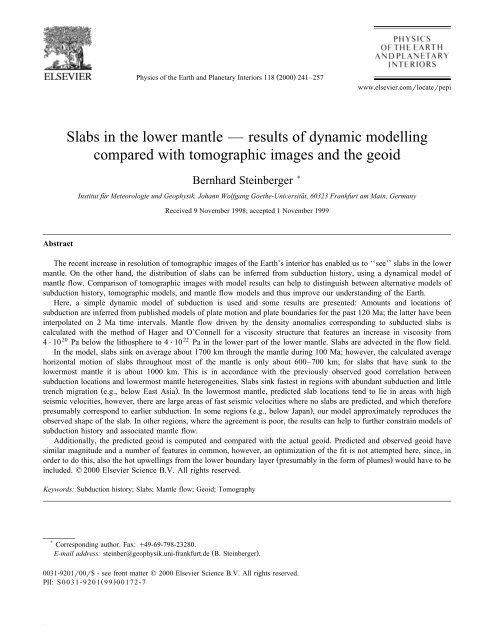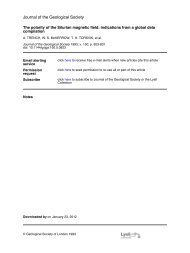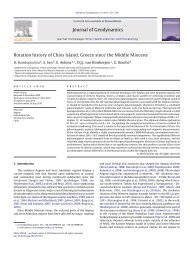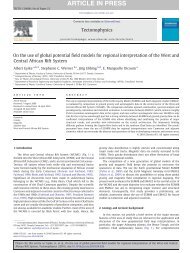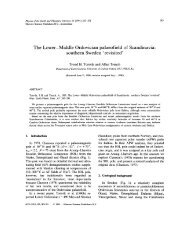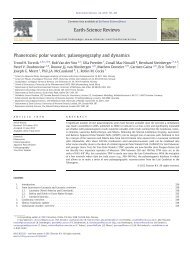Slabs in the lower mantle — results of dynamic modelling compared ...
Slabs in the lower mantle — results of dynamic modelling compared ...
Slabs in the lower mantle — results of dynamic modelling compared ...
Create successful ePaper yourself
Turn your PDF publications into a flip-book with our unique Google optimized e-Paper software.
244( )B. Ste<strong>in</strong>bergerrPhysics <strong>of</strong> <strong>the</strong> Earth and Planetary Interiors 118 2000 241–257Fig. 1. Slab <strong>in</strong>put model: The figure shows locations, times and masses <strong>of</strong> slab ‘‘particles’’ <strong>in</strong>serted <strong>in</strong>to <strong>the</strong> <strong>mantle</strong> at a depth 380 km. Itcorresponds to <strong>the</strong> subduction history model shown <strong>in</strong> Ste<strong>in</strong>berger and O’Connell Ž 1998 ., which <strong>in</strong> turn is based on <strong>the</strong> data <strong>of</strong> Gordon andJurdy Ž 1986. and Lithgow-Bertelloni et al. Ž 1993 .. Areas <strong>of</strong> dots correspond to masses <strong>of</strong> particles, however, overlap between dots occurs.See text for details on how slab <strong>in</strong>put model was obta<strong>in</strong>ed.calculated on <strong>the</strong> grid, and subsequently expanded <strong>in</strong>spherical harmonics up to degree and order 31.Spherical harmonic expansion is facilitated by <strong>the</strong>specific choice <strong>of</strong> gridpo<strong>in</strong>ts. After this, <strong>the</strong> method<strong>of</strong> Hager and O’Connell Ž 1979, 1981.is used tocalculate <strong>the</strong> flow field. This method essentiallycomputes a spherical harmonic expansion <strong>of</strong> <strong>the</strong> flowfield, given spherical harmonic expansions <strong>of</strong> <strong>the</strong>density field and surface plate motions, and a radialviscosity structure. A more detailed description <strong>of</strong><strong>the</strong> method has been given by Ste<strong>in</strong>berger andO’Connell Ž 1998 .. Žn.b.: There should be a m<strong>in</strong>ussign<strong>in</strong>stead <strong>of</strong> a plus-sign <strong>in</strong> <strong>the</strong> third l<strong>in</strong>es <strong>of</strong> Eqs.Ž A2. and Ž A3.<strong>of</strong> that paper. These equations weremispr<strong>in</strong>ted, but used correctly..Here, <strong>the</strong> orig<strong>in</strong>al rout<strong>in</strong>es were modified to <strong>in</strong>clude<strong>the</strong> effects <strong>of</strong> compressibility and phase boundaries:The latter are <strong>in</strong>cluded as mass sheets on <strong>the</strong>undeflected boundary that correspond to <strong>the</strong> massanomalies caused by <strong>the</strong> phase boundary deflection.Two phase boundaries Žat depth 400 km with aproduct <strong>of</strong> Clapeyron slope and density jump 0.5P10 3MParKkgrm 3 and at depth 670 km with y0.3P10 3MParK kgrm 3. are <strong>in</strong>cluded. The value at 400 kmis based on Akaogi et al. Ž 1989.for a Pyrolite <strong>mantle</strong>with 60% Oliv<strong>in</strong>e content. The value at 670 km isgiven by Akaogi and Ito Ž 1999 .. It is smaller thanvalues assumed <strong>in</strong> many convection calculations, asit also <strong>in</strong>cludes <strong>the</strong> effects <strong>of</strong> <strong>the</strong> Majorite–Perovskitetransition, which occurs at a similar depthwith a positive Clapeyron slope. With <strong>the</strong>se parameters,<strong>the</strong> effects <strong>of</strong> phase boundaries are found to bera<strong>the</strong>r small, <strong>in</strong> agreement with <strong>the</strong> <strong>results</strong> by Bungeet al. Ž 1998 .: They <strong>compared</strong> two convection simulations,one with ra<strong>the</strong>r strong phase boundaries andone without phase boundaries and found a better fit
( )B. Ste<strong>in</strong>bergerrPhysics <strong>of</strong> <strong>the</strong> Earth and Planetary Interiors 118 2000 241–257 245to Grand’s model <strong>in</strong> <strong>the</strong> case without phase boundaries.Includ<strong>in</strong>g compressibility does not have a largeeffect ei<strong>the</strong>r.Only slabs that have been subducted below 380km are used to calculate flow. S<strong>in</strong>ce <strong>the</strong> motion <strong>of</strong>slabs above 380 km is calculated k<strong>in</strong>ematically, itwould be <strong>the</strong> most consistent approach to use <strong>the</strong>slabs as k<strong>in</strong>ematic boundary conditions for <strong>the</strong> flow.However, this has not been done s<strong>in</strong>ce <strong>the</strong> numericalimplementation would take considerable effort.Moreover, s<strong>in</strong>ce plate motions are already used ask<strong>in</strong>ematic boundary conditions at <strong>the</strong> surface, <strong>mantle</strong>flow already has a downward component <strong>of</strong> magnitudesimilar to convergence rate below subductionzones. Thus, <strong>in</strong>clud<strong>in</strong>g subducted slabs as fur<strong>the</strong>rboundary conditions would presumably not change<strong>results</strong> by much. Whe<strong>the</strong>r or not slabs <strong>in</strong> <strong>the</strong> uppermost380 km are <strong>in</strong>cluded <strong>in</strong> <strong>the</strong> flow calculationdoes not have much effect on <strong>the</strong> flow field <strong>in</strong> <strong>the</strong><strong>lower</strong> <strong>mantle</strong>, hence on <strong>the</strong> <strong>results</strong>.Anomalous masses <strong>of</strong> slab particles are assumedto decrease proportional to <strong>the</strong>ir radial coord<strong>in</strong>ateŽ sEarth radius m<strong>in</strong>us depth ., thus approximatelyaccount<strong>in</strong>g for <strong>the</strong> decrease <strong>of</strong> <strong>the</strong>rmal expansioncoefficient with depth Ž Chopelas and Boehler, 1989 ..Results do not strongly depend on <strong>the</strong> exact depthdependence <strong>of</strong> anomalous mass chosen.2.3. Viscosity structureŽ .The method <strong>of</strong> Hager and O’Connell 1979, 1981enables flow calculation for a viscosity vary<strong>in</strong>g withFig. 3. Calculated present depth <strong>of</strong> slab particles vs. time <strong>of</strong>subduction Ž below 380 km .. Each dot corresponds to one slabparticle. The black l<strong>in</strong>e shows <strong>the</strong> average depth <strong>of</strong> slab particlesfor a given time <strong>of</strong> subduction.radius only. The viscosity structure used here isshown <strong>in</strong> Fig. 2, and is <strong>the</strong> same as <strong>in</strong> Ste<strong>in</strong>bergerŽ 2000 ., where it was discussed that it is <strong>in</strong> agreementwith evidence from postglacial rebound and <strong>the</strong>geoid, and a review <strong>of</strong> this evidence was given. Therelative values <strong>of</strong> lithospheric, as<strong>the</strong>nospheric andFig. 2. Viscosity structure used, and correspond<strong>in</strong>g geoid kernels Žcalculated for a free upper boundary with <strong>the</strong> method described byPanasyuk et al., 1996.for spherical harmonic degrees 2–12, graytone correspond<strong>in</strong>g to degree.
246( )B. Ste<strong>in</strong>bergerrPhysics <strong>of</strong> <strong>the</strong> Earth and Planetary Interiors 118 2000 241–257<strong>lower</strong> <strong>mantle</strong> viscosity were especially chosen toallow an acceptable fit <strong>of</strong> <strong>the</strong> observed geoid; kernelsare very similar to <strong>the</strong> viscosity structure for whichRicard et al. Ž 1993.found an optimum fit <strong>of</strong> <strong>the</strong>geoid, us<strong>in</strong>g a similar, but somewhat simpler model<strong>of</strong> subduction. Specifically, geoid kernels that aresignificantly negative <strong>in</strong> <strong>the</strong> <strong>lower</strong> <strong>mantle</strong> are requiredto predict a geoid similar to <strong>the</strong> observed one.Obviously, <strong>the</strong> neglect <strong>of</strong> lateral viscosity variationsis one <strong>of</strong> <strong>the</strong> fundamental limitations <strong>of</strong> thisand o<strong>the</strong>r studies on this subject. Lateral viscosityvariations are, however, poorly known and difficultto implement numerically Ž e.g., Gurnis et al., 1998 ..Moreover, like <strong>the</strong> s<strong>in</strong>k<strong>in</strong>g speed <strong>of</strong> a viscous spherethat is mostly determ<strong>in</strong>ed by <strong>the</strong> viscosity <strong>of</strong> <strong>the</strong>surround<strong>in</strong>g fluid, it can be expected that <strong>the</strong> s<strong>in</strong>k<strong>in</strong>gspeed <strong>of</strong> slabs depends mostly on ambient <strong>mantle</strong>viscosity and not so much on <strong>the</strong> <strong>in</strong>ternal slab rheology,<strong>in</strong> which case <strong>the</strong> use <strong>of</strong> a viscosity structurevary<strong>in</strong>g with radius only would be reasonable.2.4. Motion <strong>of</strong> slab particles <strong>in</strong> <strong>mantle</strong> flowIn pr<strong>in</strong>ciple, <strong>the</strong> motion <strong>of</strong> slabs can be calculatedby simply <strong>in</strong>terpolat<strong>in</strong>g <strong>the</strong> flow field from <strong>the</strong> gridto <strong>the</strong> locations <strong>of</strong> <strong>the</strong> slab particles. However, <strong>the</strong>model <strong>of</strong> plate boundaries used starts at 120 Ma,whereas <strong>in</strong> <strong>the</strong> real Earth, <strong>the</strong>re has been subductionfor much longer. Therefore at early times our slabmodel would significantly underpredict flow speedsand <strong>the</strong> calculated slab s<strong>in</strong>k<strong>in</strong>g speed would be tooslow. To compensate for this, and to obta<strong>in</strong> a morerealistic <strong>in</strong>itial condition, we start <strong>the</strong> calculation 220Ma ago, with constant subduction locations for <strong>the</strong>first 110 Ma, similar to Bunge et al. Ž 1998 .. Whendiscuss<strong>in</strong>g <strong>the</strong> distribution <strong>of</strong> slabs, <strong>in</strong>ferred densityFig. 4. Calculated vertical flow component at depth 0.72r . Downward flow only is shown. Thick black l<strong>in</strong>es <strong>in</strong>dicate locations <strong>of</strong> crossEŽ .sections shown <strong>in</strong> Figs. 7–9. Letters s,t,u <strong>in</strong>dicate places mentioned <strong>in</strong> <strong>the</strong> text.
( )B. Ste<strong>in</strong>bergerrPhysics <strong>of</strong> <strong>the</strong> Earth and Planetary Interiors 118 2000 241–257 247distribution and comparison with tomography and<strong>the</strong> geoid Ži.e., for <strong>the</strong> <strong>results</strong> displayed <strong>in</strong> Figs.5–11 ., we will however only use slabs <strong>in</strong>serted after120 Ma, which are based on an actual plate motionhistory model.3. Results <strong>of</strong> <strong>mantle</strong> flow and slab distribution3.1. S<strong>in</strong>k<strong>in</strong>g speed <strong>of</strong> slabsThe previously found good correlation between<strong>lower</strong>most <strong>mantle</strong> seismic heterogeneity and Cenozoicand Mesozoic subduction history Že.g., Richardsand Engebretson, 1992.suggests that slabs take <strong>of</strong><strong>the</strong> order <strong>of</strong> 100 Ma to s<strong>in</strong>k to <strong>the</strong> <strong>lower</strong>most <strong>mantle</strong>.Our <strong>results</strong> are <strong>in</strong> accordance: Fig. 3 shows that slabsthat have been subducted 120 Ma ago or earlier havesunk to with<strong>in</strong> a few hundred kilometers <strong>of</strong> <strong>the</strong> CMBon average. The average depth <strong>of</strong> slabs subductedlater than 120 Ma as a function <strong>of</strong> subduction time<strong>in</strong>dicates an average s<strong>in</strong>k<strong>in</strong>g speed <strong>of</strong> <strong>the</strong> order <strong>of</strong>2000 kmr120 Maf1.7 cmryear. This value isprobably slightly over-estimated, because a constantsubduction location prior to 110 Ma was assumed,and <strong>in</strong> this case, s<strong>in</strong>k<strong>in</strong>g speeds tend to be higherthan <strong>in</strong> <strong>the</strong> case <strong>of</strong> rapid trench migration, as will bediscussed below. Calculations for a variety <strong>of</strong> o<strong>the</strong>rmodels Žwith different viscosity structures, phaseboundary parameters, <strong>the</strong>rmal expansivity, etc..yielded ra<strong>the</strong>r similar <strong>results</strong>. The largest uncerta<strong>in</strong>tiesarise from <strong>the</strong> ra<strong>the</strong>r poor knowledge <strong>of</strong> <strong>lower</strong><strong>mantle</strong> viscosity, which might be a few times higheror <strong>lower</strong>, but even so, comparison <strong>of</strong> various model<strong>results</strong> <strong>in</strong>dicate uncerta<strong>in</strong>ties <strong>in</strong> average s<strong>in</strong>k<strong>in</strong>g speed<strong>of</strong> a few tens <strong>of</strong> percent at most.Lateral variations <strong>of</strong> s<strong>in</strong>k<strong>in</strong>g speed are, however,much larger, and thus need to be considered whencompar<strong>in</strong>g predicted density anomalies with <strong>results</strong>from seismic tomography. Fig. 4 shows <strong>the</strong> verticalcomponent <strong>of</strong> <strong>the</strong> <strong>mantle</strong> flow field at a depth halfwayFig. 5. Calculated present distribution <strong>of</strong> slabs. Areas <strong>of</strong> dots correspond to masses <strong>of</strong> particles, however overlap between dots occurs.Ž .Letters n,o,p,q,r <strong>in</strong>dicate places mentioned <strong>in</strong> <strong>the</strong> text. Only slabs that have been <strong>in</strong>serted <strong>in</strong>to <strong>the</strong> <strong>mantle</strong> below 380 km depth are plotted.
248( )B. Ste<strong>in</strong>bergerrPhysics <strong>of</strong> <strong>the</strong> Earth and Planetary Interiors 118 2000 241–257between transition zone and CMB: The maximums<strong>in</strong>k<strong>in</strong>g speed is about twice <strong>the</strong> average slab s<strong>in</strong>k<strong>in</strong>gspeed <strong>in</strong>ferred from Fig. 3. Correspond<strong>in</strong>gly, <strong>the</strong>fastest s<strong>in</strong>k<strong>in</strong>g slabs reach <strong>the</strong> <strong>lower</strong>most <strong>mantle</strong>after only about 60 Ma, as can also be seen <strong>in</strong> Fig. 3.High s<strong>in</strong>k<strong>in</strong>g speeds tend to occur <strong>in</strong> regions withlarge amounts <strong>of</strong> subduction and little trench migration.Fig. 6. Predictions <strong>of</strong> density anomalies <strong>in</strong> <strong>the</strong> <strong>mantle</strong> from subduction history <strong>compared</strong> with tomographic models <strong>—</strong> depth averages <strong>of</strong>four different <strong>mantle</strong> depth <strong>in</strong>tervals. Only positive anomalies are shown. Thick black l<strong>in</strong>es <strong>in</strong>dicate locations <strong>of</strong> cross-sections shown <strong>in</strong>Figs. 7–9. Letters Ž a,b,c,d,e,f,v,w.<strong>in</strong>dicate places mentioned <strong>in</strong> <strong>the</strong> text.
( )B. Ste<strong>in</strong>bergerrPhysics <strong>of</strong> <strong>the</strong> Earth and Planetary Interiors 118 2000 241–257 249Ž .Fig. 6 cont<strong>in</strong>ued .3.2. Magnitude and lateral distribution <strong>of</strong> densityanomalies due to slabsFig. 5 shows <strong>the</strong> calculated present distribution <strong>of</strong>slabs: <strong>in</strong> order to compare <strong>results</strong> with tomographicmodels <strong>of</strong> wave speed, it is however more useful tocompute <strong>the</strong> correspond<strong>in</strong>g density field: Because <strong>of</strong><strong>the</strong> uncerta<strong>in</strong>ties <strong>in</strong> our model parameters, hence slabs<strong>in</strong>k<strong>in</strong>g speed, slab locations may be predicted somewhattoo deep or too shallow. It is <strong>the</strong>refore moreappropriate to compare not at given depth levels, butaveraged over certa<strong>in</strong> depth <strong>in</strong>tervals: In Fig. 6, <strong>the</strong>
250( )B. Ste<strong>in</strong>bergerrPhysics <strong>of</strong> <strong>the</strong> Earth and Planetary Interiors 118 2000 241–257<strong>mantle</strong> is divided <strong>in</strong> four <strong>in</strong>tervals spann<strong>in</strong>g 600 kmeach. The p-wave model <strong>of</strong> Karason ´ et al. Ž 1997 .,and <strong>the</strong> latest s-wave model by S. Grand Ž1998, pers.comm. ., which is similar to Grand et al. Ž 1997.areused for comparison. These models were chosenbecause <strong>of</strong> <strong>the</strong>ir high resolution, but <strong>the</strong> choice doesnot imply judgment regard<strong>in</strong>g <strong>the</strong> quality <strong>of</strong> anymodel. These models were converted from <strong>the</strong> orig<strong>in</strong>algrid to spherical harmonic coefficients and subsequentlyre-evaluated <strong>in</strong> space doma<strong>in</strong>, us<strong>in</strong>g coefficientsup to degree and order 31, as for <strong>the</strong> slabmodel.The computed magnitude <strong>of</strong> <strong>the</strong> density anomaliesis up to about 0.5% <strong>in</strong> <strong>the</strong> upper three layers andsomewhat larger <strong>in</strong> <strong>the</strong> <strong>lower</strong>most <strong>mantle</strong>. For comparison,below 500 km depth <strong>the</strong> anomalies <strong>of</strong> <strong>the</strong>s-wave model have similar magnitude Žexcept <strong>in</strong> <strong>the</strong><strong>lower</strong>most <strong>mantle</strong>, where <strong>the</strong>y are larger ., <strong>the</strong>anomalies <strong>of</strong> <strong>the</strong> p-wave model are even smaller.Based on m<strong>in</strong>eral physics arguments, however, relativedensity anomalies should be <strong>of</strong> <strong>the</strong> order <strong>of</strong>0.2–0.3 times relative s-wave speed anomalies, or0.4–0.5 times relative p-wave anomalies Že.g.,Karato, 1993 ., <strong>in</strong>dicat<strong>in</strong>g that ei<strong>the</strong>r <strong>the</strong> anomalies <strong>of</strong><strong>the</strong> tomographic models are too small or <strong>the</strong> predicteddensity anomalies are too large. Compared too<strong>the</strong>r tomographic models, Že.g., Su et al., 1994; Liand Romanowicz, 1996.<strong>the</strong> amplitude <strong>of</strong> <strong>the</strong> modelsby Grand Ž 1998. and Karason ´ et al. Ž 1997.is <strong>in</strong>deedsomewhat low.In <strong>the</strong> uppermost layer Ž 500–1100 km ., <strong>the</strong> predicteddensity anomaly <strong>in</strong> most places represents <strong>the</strong>recent subduction history, with positive anomalies <strong>in</strong><strong>the</strong> regions surround<strong>in</strong>g <strong>the</strong> Pacific, and <strong>in</strong> an areastretch<strong>in</strong>g from <strong>the</strong> Mediterranean to Indonesia, correspond<strong>in</strong>gto <strong>the</strong> former Thetys subduction. Most <strong>of</strong><strong>the</strong> positive velocity anomalies <strong>of</strong> <strong>the</strong> seismic modelsare also <strong>in</strong> <strong>the</strong>se regions. The models also agree <strong>in</strong>some <strong>of</strong> <strong>the</strong> details: all three models show an elongatedanomaly stretch<strong>in</strong>g through <strong>the</strong> Americas, withFig. 7. Predicted density anomalies and flow due to subduction atthree different times, and seismic p- and s-wave anomalies underNorth America <strong>—</strong> vertical cross-section at 388N. Length <strong>of</strong>arrows corresponds to total flow <strong>in</strong> 20 Ma; only positive anomaliesare shown. A thick black l<strong>in</strong>e <strong>in</strong>dicates where flow is displayed<strong>in</strong> Fig. 4.
( )B. Ste<strong>in</strong>bergerrPhysics <strong>of</strong> <strong>the</strong> Earth and Planetary Interiors 118 2000 241–257 251a maximum beneath <strong>the</strong> nor<strong>the</strong>rn part <strong>of</strong> SouthAmerica Ž. a . Also, all three models show a maximumbeneath Indonesia Ž. b . In many o<strong>the</strong>r places,<strong>the</strong> models show considerable differences, which canbe due to a variety <strong>of</strong> reasons: The <strong>in</strong>terpretation <strong>of</strong>seismic anomalies <strong>in</strong> terms <strong>of</strong> density anomalies isnot obvious, because p- and s- wave anomalies donot correlate well everywhere, as seen <strong>in</strong> Fig. 6; <strong>the</strong>subduction history model used may be <strong>in</strong>accurate <strong>in</strong>places; <strong>the</strong> <strong>mantle</strong> flow model used may be toosimplistic.In <strong>the</strong> next layer Ž 1100–1700 km ., <strong>the</strong> maximumbeneath <strong>the</strong> Americas is fur<strong>the</strong>r north <strong>—</strong> roughlybeneath <strong>the</strong> Caribbean <strong>in</strong> all three models Ž. c . Themaximum <strong>of</strong> <strong>the</strong> anomaly correspond<strong>in</strong>g to Thetyssubduction is fur<strong>the</strong>r west <strong>—</strong> roughly beneath India<strong>in</strong> all three models Ž. d . Aga<strong>in</strong>, <strong>the</strong> models disagree <strong>in</strong>o<strong>the</strong>r areas for <strong>the</strong> reasons mentioned above.In <strong>the</strong> <strong>lower</strong> part <strong>of</strong> <strong>lower</strong> <strong>mantle</strong>, <strong>the</strong> predicteddensity anomalies rema<strong>in</strong> <strong>in</strong> similar areas Žbelow <strong>the</strong>Thetys region and around <strong>the</strong> Pacific.and an additionalanomaly correspond<strong>in</strong>g to <strong>the</strong> Mesozoic subductionbetween Izanagi and Farallon plates <strong>in</strong> <strong>the</strong>Nor<strong>the</strong>rn Pacific Ž. e becomes prom<strong>in</strong>ent. Also, as ageneral feature, when go<strong>in</strong>g down <strong>in</strong> <strong>the</strong> <strong>mantle</strong>, <strong>the</strong>predicted anomalies become more patchy and lessl<strong>in</strong>ear features. Comparison with seismic anomaliesbecomes even more difficult <strong>in</strong> <strong>the</strong> <strong>lower</strong>most twolayers: p- and s-wave anomalies look considerablydifferent, which may be due to chemical heterogeneitiesŽ Kennett et al., 1998 .. The <strong>in</strong>terpretation <strong>of</strong>seismic anomalies <strong>in</strong> terms <strong>of</strong> density anomalies<strong>the</strong>refore becomes less obvious. Also, <strong>the</strong> <strong>lower</strong>most<strong>mantle</strong> must conta<strong>in</strong> <strong>the</strong> rema<strong>in</strong>s <strong>of</strong> slabs subductedearlier than 120 Ma ago, which are not <strong>in</strong>cluded <strong>in</strong><strong>the</strong> model. Especially <strong>in</strong> <strong>the</strong> <strong>lower</strong>most layer, wecannot expect that <strong>the</strong> model would predict all densityanomalies. For example, although <strong>the</strong> predicteddensity anomaly beneath Asia extends fur<strong>the</strong>r westthan <strong>the</strong> locations <strong>of</strong> subduction dur<strong>in</strong>g <strong>the</strong> past 120Fig. 8. Predicted density anomalies and flow due to subduction atthree different times, and seismic p- and s-wave anomalies underEast Asia <strong>—</strong> vertical cross-section at 388N. Length <strong>of</strong> arrowscorresponds to total flow <strong>in</strong> 20 Ma; only positive anomalies areshown. A thick black l<strong>in</strong>e <strong>in</strong>dicates where flow is displayed <strong>in</strong>Fig. 4.
252( )B. Ste<strong>in</strong>bergerrPhysics <strong>of</strong> <strong>the</strong> Earth and Planetary Interiors 118 2000 241–257Ma, <strong>the</strong> anomaly seen <strong>in</strong> both tomographic modelsbeneath Asia is considerably larger <strong>in</strong> extent andstretches even fur<strong>the</strong>r west Ž. f . This is most likelydue to earlier subduction, as discussed by van derVoo et al. Ž 1999 ..3.3. Cross-sections through <strong>mantle</strong>In <strong>the</strong> follow<strong>in</strong>g, some cross-sections through <strong>the</strong>flow and density fields are shown: The regions displayedare on <strong>the</strong> surface <strong>of</strong> a cone, but <strong>the</strong>y aremapped on to rectangles for convenience. Thecross-sections only show vertical and east–westcomponent <strong>of</strong> <strong>the</strong> flow, although flow calculationsare done <strong>in</strong> three dimensions <strong>in</strong> spherical geometry.A cross-section beneath North America is shown<strong>in</strong> Fig. 7, because <strong>the</strong> eastward dipp<strong>in</strong>g positiveanomaly <strong>in</strong> both p- and s-wave speed has been one<strong>of</strong> <strong>the</strong> first strong evidences for slabs penetrat<strong>in</strong>g <strong>in</strong>to<strong>the</strong> <strong>lower</strong> <strong>mantle</strong> Ž Grand, 1994 .. Here, it is <strong>the</strong>reforetested whe<strong>the</strong>r such a feature can be reproduced. Thecalculated density anomaly is <strong>in</strong> a similar locationand has a similar shape: It also dips eastward, however,it is not as straight and dips less steeply. Thismight <strong>in</strong>dicate that <strong>in</strong> this region <strong>the</strong> model somewhatunderpredicts <strong>the</strong> slab s<strong>in</strong>k<strong>in</strong>g speed. The panelat 40 Ma ago shows <strong>the</strong> effect <strong>of</strong> <strong>the</strong> phase boundary<strong>in</strong> <strong>the</strong> calculations: <strong>Slabs</strong> pile up at <strong>the</strong> Sp<strong>in</strong>el–Perovskitetransition before <strong>the</strong>y eventually penetrate<strong>in</strong>to <strong>the</strong> <strong>lower</strong> <strong>mantle</strong>.Fig. 8 shows a cross-section beneath East Asia.Aga<strong>in</strong>, <strong>the</strong> prediction and <strong>the</strong> tomographic imagesshow an anomaly <strong>in</strong> a similar region and <strong>of</strong> similarshape: beg<strong>in</strong>n<strong>in</strong>g <strong>in</strong> <strong>the</strong> upper <strong>mantle</strong> beneath JapanŽ ;1408E.it stretches fur<strong>the</strong>r west across <strong>the</strong> transitionzone, and is more or less vertical <strong>in</strong> <strong>the</strong> <strong>lower</strong><strong>mantle</strong>, go<strong>in</strong>g all <strong>the</strong> way to <strong>the</strong> CMB. Aga<strong>in</strong>, especially<strong>in</strong> <strong>the</strong> <strong>lower</strong>most <strong>mantle</strong>, <strong>the</strong> predicted anomalyis not as extensive as observed, as <strong>the</strong> model doesnot <strong>in</strong>clude subduction earlier than 120 Ma. In thisFig. 9. Predicted density anomalies and flow due to subduction atthree different times, and seismic p- and s-wave anomalies underAustralia <strong>—</strong> vertical cross-section at 388S. Length <strong>of</strong> arrowscorresponds to total flow <strong>in</strong> 20 Ma; only positive anomalies areshown. A thick black l<strong>in</strong>e <strong>in</strong>dicates where flow is displayed <strong>in</strong>Fig. 4.
( )B. Ste<strong>in</strong>bergerrPhysics <strong>of</strong> <strong>the</strong> Earth and Planetary Interiors 118 2000 241–257 253region, <strong>the</strong> calculated effect <strong>of</strong> <strong>the</strong> phase transition isvery small.F<strong>in</strong>ally, Fig. 9, show<strong>in</strong>g a cross-section south <strong>of</strong>Australia, ra<strong>the</strong>r serves to <strong>in</strong>dicate problems still tobe overcome: Here, <strong>the</strong> tomographic models do notagree well, and <strong>the</strong> predicted density anomaly doesnot resemble ei<strong>the</strong>r <strong>of</strong> <strong>the</strong>m.4. Slab distribution and <strong>the</strong> geoidThe <strong>the</strong>ory relat<strong>in</strong>g <strong>mantle</strong> density heterogeneitiesand geoid has been developed by Richards and HagerŽ 1984. and Ricard et al. Ž 1984 .. Hager Ž 1984.showedthat a good fit to <strong>the</strong> geoid at spherical harmonicdegrees 4–9 can be achieved if <strong>the</strong>se density anomaliesare <strong>in</strong>ferred from <strong>the</strong> locations <strong>of</strong> subductedslabs. More recently, Ricard et al. Ž 1993.were ableto expla<strong>in</strong> 73% <strong>of</strong> <strong>the</strong> first eight spherical harmonicdegrees <strong>of</strong> <strong>the</strong> geoid, us<strong>in</strong>g a subduction historymodel. Both studies <strong>in</strong>dicated a significant viscosity<strong>in</strong>crease with depth Ž factor 30–100 .. Here, geoidkernels are computed with <strong>the</strong> method described byPanasyuk et al. Ž 1996 .; <strong>the</strong> geoid is computed byconvolv<strong>in</strong>g <strong>the</strong>se kernels with <strong>the</strong> density anomaly<strong>in</strong>ferred from slabs. There is a slight <strong>in</strong>consistency <strong>in</strong>this procedure, as <strong>the</strong> geoid kernels were computedfor a ‘‘free’’ upper boundary Žalthough with a lithosphere15 times more viscous than <strong>the</strong> <strong>mantle</strong> beneath., whereas <strong>the</strong> flow was calculated with <strong>the</strong>given plate motions as boundary condition. Theboundary condition for <strong>the</strong> geoid was chosen because<strong>in</strong> this way <strong>the</strong> best fit can be achieved, as waspreviously noted Ž e.g., Thoraval and Richards, 1997 ..However, <strong>the</strong> <strong>in</strong>consistency is not a serious one, as<strong>the</strong> <strong>results</strong> do not depend much on <strong>the</strong> assumedboundary condition. Even for a fixed surface boundarycondition Ži.e., zero plate motions as boundarycondition for <strong>the</strong> flow, but <strong>the</strong> same slab <strong>in</strong>putmodel.<strong>results</strong> look ra<strong>the</strong>r similar. Because <strong>of</strong> <strong>the</strong>low viscosity <strong>in</strong> <strong>the</strong> uppermost <strong>mantle</strong>, <strong>in</strong> <strong>the</strong> modelplate motions are not strongly coupled to flow <strong>in</strong> <strong>the</strong><strong>lower</strong> <strong>mantle</strong>, and motion <strong>of</strong> <strong>the</strong> slabs <strong>in</strong> <strong>the</strong> <strong>lower</strong><strong>mantle</strong> depends mostly on <strong>the</strong> density anomaly <strong>of</strong> <strong>the</strong>slabs <strong>the</strong>mselves and not much on <strong>the</strong> boundarycondition. In Fig. 10, predicted and observed geoidare <strong>compared</strong>. There is good visual agreement <strong>in</strong>essential features: localized geoid highs over Indone-sia Ž. g and South America Ž. h , and a ra<strong>the</strong>r broadgeoid high over Africa Ž. i , geoid lows over nor<strong>the</strong>asternNorth America Ž. j , Siberia Ž k ., <strong>the</strong> IndianOcean Ž. l , and Antarctica Ž m ..A more qualitative comparison can also be madedirectly between <strong>the</strong> slab distribution Ž Fig. 5.and <strong>the</strong>geoid: <strong>Slabs</strong> primarily <strong>in</strong> <strong>the</strong> <strong>lower</strong> <strong>mantle</strong> Žsuch asbelow <strong>the</strong> south <strong>of</strong> India Ž. n , central Siberia Ž. o ,Arctic Canada Ž.. p tend to be associated with geoidlows, whereas slabs primarily <strong>in</strong> <strong>the</strong> upper <strong>mantle</strong>Žsuch as below New Gu<strong>in</strong>ea and surround<strong>in</strong>gs Ž q .,South America Ž.. r tend to be associated with geoidhighs. Aga<strong>in</strong>, this po<strong>in</strong>ts toward geoid kernels thatare negative <strong>in</strong> <strong>the</strong> <strong>lower</strong>most part <strong>of</strong> <strong>the</strong> <strong>mantle</strong> andpositive <strong>in</strong> <strong>the</strong> upper part. The viscosity structureused here yields geoid kernels that show <strong>the</strong>se characteristicsat least for low spherical harmonic degrees.Predicted and observed geoid have similarmagnitude, however, predicted geoid highs are higherthan observed, predicted lows are not as low asobserved. One reason for this discrepancy may bethat geoid kernels ought to be less positive <strong>in</strong> <strong>the</strong>upper <strong>mantle</strong> and more negative <strong>in</strong> <strong>the</strong> <strong>lower</strong> <strong>mantle</strong>than <strong>the</strong> ones used here.No attempt was made to optimize <strong>the</strong> fit to <strong>the</strong>geoid, with a more systematic search through parameterspace. This would be beyond <strong>the</strong> scope <strong>of</strong> thispaper, especially s<strong>in</strong>ce this model does not <strong>in</strong>cludeall density anomalies expected <strong>in</strong> <strong>the</strong> <strong>mantle</strong>: subductedslabs orig<strong>in</strong>ate at <strong>the</strong> upper <strong>the</strong>rmal boundarylayer <strong>of</strong> <strong>the</strong> <strong>mantle</strong>, but <strong>the</strong>re is also a <strong>lower</strong> <strong>the</strong>rmalboundary layer that presumably gives rise to densityheterogeneities <strong>in</strong> <strong>the</strong> form <strong>of</strong> <strong>mantle</strong> plumes. Because<strong>of</strong> higher viscosities <strong>in</strong> <strong>the</strong> <strong>lower</strong>most <strong>mantle</strong>,it can be expected that plume conduits <strong>in</strong> <strong>the</strong> <strong>lower</strong>most<strong>mantle</strong> are significantly thicker than closer to<strong>the</strong> surface. If, as <strong>in</strong> this model, geoid kernels arenegative <strong>in</strong> <strong>the</strong> <strong>lower</strong>most <strong>mantle</strong> at low sphericalharmonic degrees, a high number <strong>of</strong> plumes per areawill correspond to geoid highs at low spherical harmonicdegrees. The observed distribution <strong>of</strong> hotspotsand calculations <strong>of</strong> <strong>the</strong> shape <strong>of</strong> plume conduitsŽ Ste<strong>in</strong>berger, 2000.suggest that plume conduits <strong>in</strong><strong>the</strong> <strong>lower</strong>most <strong>mantle</strong> are particularly frequent undersou<strong>the</strong>rn Africa and <strong>the</strong> South Central Pacific, whichare <strong>in</strong> fact regions where <strong>the</strong> predicted geoid is, on alarge scale, <strong>lower</strong> than observed. A positive correlation<strong>of</strong> <strong>the</strong> residual geoid Žafter subtract<strong>in</strong>g <strong>the</strong> ef-
254( )B. Ste<strong>in</strong>bergerrPhysics <strong>of</strong> <strong>the</strong> Earth and Planetary Interiors 118 2000 241–257Fig. 10. Geoid ‘‘predicted’’ by convolv<strong>in</strong>g <strong>the</strong> calculated density anomaly due to subducted slabs with <strong>the</strong> kernels shown <strong>in</strong> Fig. 2. TheŽ .observed geoid is shown for comparison. Letters g,h,i,j,k,l,m <strong>in</strong>dicate places mentioned <strong>in</strong> text.
( )B. Ste<strong>in</strong>bergerrPhysics <strong>of</strong> <strong>the</strong> Earth and Planetary Interiors 118 2000 241–257 255fects <strong>of</strong> subducted slabs.with <strong>the</strong> hotspot distributionhas also been previously reported Že.g., Richardset al., 1988 ..5. ConclusionsThe <strong>results</strong> presented here do not differ dramaticallyfrom previous <strong>results</strong>. The average s<strong>in</strong>k<strong>in</strong>gspeeds that were determ<strong>in</strong>ed here are similar to whatpreviously has been assumed. In most cases, lateralmotion <strong>of</strong> slabs was found to be small, as shown <strong>in</strong>Fig. 11, thus largely justify<strong>in</strong>g <strong>the</strong> assumption <strong>of</strong>vertical s<strong>in</strong>k<strong>in</strong>g that was used <strong>in</strong> some previousmodels. Lateral variations <strong>of</strong> s<strong>in</strong>k<strong>in</strong>g speed are, however,significant: The fastest s<strong>in</strong>k<strong>in</strong>g speeds result,where a lot <strong>of</strong> anomalous slab mass is subducted <strong>in</strong><strong>the</strong> same area Ž i.e., without much trench migration ..Fig. 4 shows <strong>the</strong> present maxima <strong>of</strong> s<strong>in</strong>k<strong>in</strong>g speed <strong>in</strong><strong>the</strong> mid-<strong>mantle</strong> beneath Ch<strong>in</strong>arSouth East Asia Ž. s ,<strong>the</strong> Caribbean Ž. t , and <strong>the</strong> Scotia Sea Ž u ..In regions where <strong>the</strong> s<strong>in</strong>k<strong>in</strong>g speed has been fast,<strong>the</strong> model predicts that slabs subducted dur<strong>in</strong>g <strong>the</strong>past 120 Ma have already sunk close to <strong>the</strong> CMBand spread laterally: Examples can be seen <strong>in</strong> Fig. 6beneath Asia Ž. f , <strong>the</strong> nor<strong>the</strong>rn Pacific Ž. e , and <strong>the</strong>Atlantic east <strong>of</strong> <strong>the</strong> Caribbean Ž. v , as well as <strong>the</strong>Fig. 11. Horizontal displacement <strong>of</strong> subducted slab particles between<strong>the</strong>ir <strong>in</strong>itial location at depth 380 km and <strong>the</strong>ir presentlocation. Each gray dot corresponds to one slab particle. The blackl<strong>in</strong>e shows <strong>the</strong> average displacement <strong>of</strong> particles <strong>in</strong> sphericalshells <strong>of</strong> thickness 0.01 Earth radii.South Atlantic Ž w .. In <strong>the</strong>se areas, strong positiveanomalies are predicted <strong>in</strong> <strong>the</strong> <strong>lower</strong>most <strong>mantle</strong>,without subduction hav<strong>in</strong>g occurred immediatelyabove <strong>in</strong> <strong>the</strong> slab <strong>in</strong>put model Ž Fig. 1 .. In accordance,both p- and s-wave models show large positiveanomalies <strong>in</strong> <strong>the</strong> same region beneath Asia Ž. f ,and positive anomalies <strong>in</strong> a similar region beneath<strong>the</strong> nor<strong>the</strong>rn Pacific Ž. e ; <strong>the</strong> s-wave model also haspositive anomalies <strong>in</strong> <strong>the</strong> same two regions beneath<strong>the</strong> Atlantic Ž. v and Ž w .. A ra<strong>the</strong>r large <strong>of</strong>fset betweensubduction locations and slab location <strong>in</strong> <strong>the</strong><strong>lower</strong>most <strong>mantle</strong> is also predicted <strong>in</strong> <strong>the</strong> Indianocean Ž. n . Aga<strong>in</strong>, <strong>the</strong>re are positive p- and s-waveanomalies close to where <strong>the</strong> slabs are predicted.Both tomographic models also have some localizedstrong negative velocity anomalies Ž not shown .,which are most likely unrelated to subduction. Additionally,<strong>the</strong> tomographic models have strong positiveanomalies <strong>in</strong> some regions <strong>of</strong> <strong>the</strong> <strong>lower</strong>most<strong>mantle</strong> where none are predicted, and which arelikely due to earlier subduction. A significant shortcom<strong>in</strong>g<strong>of</strong> this and o<strong>the</strong>r slab models is that <strong>the</strong>models <strong>of</strong> plate motion history and hence subductionused start 120 or 180 Ma ago. Our knowledge <strong>of</strong> <strong>the</strong>history <strong>of</strong> plate motion before that is not very good,and even <strong>the</strong> model used after 120 Ma, is probablywrong <strong>in</strong> some places. Fortunately, it may not benecessary to know subduction history accuratelymuch earlier than about 150 Ma ago, as <strong>the</strong> <strong>results</strong> <strong>of</strong>Bunge et al. Ž 1998.reveal a 150-Ma time scale forgenerat<strong>in</strong>g <strong>the</strong>rmal heterogeneity <strong>in</strong> <strong>the</strong> <strong>mantle</strong>. Thehigh-resolution tomographic images can now help t<strong>of</strong>ur<strong>the</strong>r constra<strong>in</strong> models <strong>of</strong> plate motion and subductionhistory; an example shown here concerns <strong>the</strong>subduction zone <strong>in</strong> <strong>the</strong> Nor<strong>the</strong>rn Pacific, betweenIzanagi and Farallon plates, implied by Mesozoicplate reconstructions. The location <strong>of</strong> this subductionzone is not well constra<strong>in</strong>ed by plate reconstructionsalone and <strong>the</strong> good agreement between predicted andobserved anomalies Ž. e <strong>in</strong> that region helps to confirm<strong>the</strong> location. A more satisfactory approach thanus<strong>in</strong>g a given subduction history model, as done hereand <strong>in</strong> most previous studies, would be to vary platereconstructions with<strong>in</strong> <strong>the</strong>ir uncerta<strong>in</strong>ties and testwhich model best predicts tomography. Such anapproach was taken by Gurnis et al. Ž 1998.for aparticular region; to do this on a global scale will bea considerable <strong>in</strong>terdiscipl<strong>in</strong>ary research effort and is
256( )B. Ste<strong>in</strong>bergerrPhysics <strong>of</strong> <strong>the</strong> Earth and Planetary Interiors 118 2000 241–257beyond <strong>the</strong> scope <strong>of</strong> <strong>the</strong> present paper, which isma<strong>in</strong>ly <strong>in</strong>tended to demonstrate <strong>the</strong> feasibility <strong>of</strong>such an effort.The slab model does not strongly depend ondetails <strong>of</strong> <strong>the</strong> viscosity structure chosen. It can onlybe <strong>in</strong>ferred that <strong>the</strong> average viscosity <strong>of</strong> <strong>the</strong> <strong>lower</strong><strong>mantle</strong> must not be much less than about 10 22 Pa.For <strong>the</strong> viscosity structure chosen, which reaches avalue <strong>of</strong> 4P10 22 Pa <strong>in</strong> <strong>the</strong> <strong>lower</strong> <strong>mantle</strong>, slabs haveon average sunk <strong>in</strong>to <strong>the</strong> <strong>lower</strong> half <strong>of</strong> <strong>the</strong> <strong>lower</strong><strong>mantle</strong> after about 100 Ma, but some slabs comeclose to <strong>the</strong> CMB already after about 60 Ma Žsee Fig.3 .. For a viscosity much <strong>lower</strong> than that, model<strong>results</strong> show slabs reach<strong>in</strong>g <strong>the</strong> <strong>lower</strong>most <strong>mantle</strong>faster and subsequently spread<strong>in</strong>g out close to <strong>the</strong>CMB, before <strong>the</strong>y would presumably get <strong>the</strong>rmallyequilibrated <strong>—</strong> a result not <strong>in</strong> agreement with <strong>the</strong>observation that positive <strong>lower</strong>most <strong>mantle</strong> seismicanomalies tend to be beneath areas <strong>of</strong> Mesozoicsubduction and not much displaced laterally. If, on<strong>the</strong> o<strong>the</strong>r hand, a viscosity contrast much higher than100 between upper and <strong>lower</strong> <strong>mantle</strong> is chosen,predictions <strong>of</strong> <strong>the</strong> geoid become less satisfactory.Although <strong>the</strong>re are still considerable differences, aconsensus between various current models <strong>of</strong> <strong>mantle</strong>viscosity, <strong>in</strong>ferred from models <strong>of</strong> postglacial reboundand <strong>the</strong> geoid Že.g., Mitrovica and Forte,1997; Lambeck and Johnston, 1998 ., and fromhotspot motion ŽRichards, 1991; Corrieu and Ricard,1998; Ste<strong>in</strong>berger and O’Connell, 1998.beg<strong>in</strong>s toemerge. All those models <strong>in</strong>dicate a significant viscosity<strong>in</strong>crease with depth, with absolute viscosity <strong>in</strong><strong>the</strong> upper <strong>mantle</strong> typically a few times 10 20 Pa and<strong>lower</strong> <strong>mantle</strong> viscosity <strong>of</strong> <strong>the</strong> order <strong>of</strong> 10 22 Pa ormore. The viscosity model used here is <strong>in</strong> agreementwith <strong>the</strong>se general features.AcknowledgementsSpecial thanks goes to Svetlana Panasyuk forprovid<strong>in</strong>g <strong>the</strong> MATLAB code to calculate geoidkernels, and to Steve Grand and Rob van der Hilstfor shar<strong>in</strong>g <strong>the</strong>ir most recent tomographic models viaanonymous ftp. A substantial part <strong>of</strong> this work wasdone dur<strong>in</strong>g a postdoctoral fellowship at AcademiaS<strong>in</strong>ica Ž Taiwan .. Some prelim<strong>in</strong>ary work was donewith Rick O’Connell, who also provided variousFORTRAN rout<strong>in</strong>es and datasets for past plate motionsand geometries, and whom I wish to thank forcont<strong>in</strong>u<strong>in</strong>g encouragement to pursue this work. Fur<strong>the</strong>r<strong>in</strong>formation and suggestions were given by ArtCalderwood, Gabi Marquart, Harro Schmel<strong>in</strong>g,Manuela Tetzlaff and Ca<strong>the</strong>r<strong>in</strong>e Thoraval. Commentsby Yanick Ricard and an anonymous reviewer areappreciated. Figures were prepared us<strong>in</strong>g GMTgraphics Ž Wessel and Smith, 1995 ..ReferencesAkaogi, M., Ito, E., 1999. Calorimetric study on majorite–perovskitetransition <strong>in</strong> <strong>the</strong> system Mg 4Si 4O 12–Mg 3Al2Si 3O 12:transition boundaries with positive pressure–temperatureslopes. Phys. Earth Planet. Inter. 114, 129–140.Akaogi, M., Ito, E., Navrotsky, A., 1989. Oliv<strong>in</strong>e-modifiedsp<strong>in</strong>el–sp<strong>in</strong>el transitions <strong>in</strong> <strong>the</strong> system Mg 2SiO 4–Fe2SiO 4:calorimetric measurements, <strong>the</strong>rmochemical calculations, andgeophysical application. J. Geophys. Res. 94, 15671–15685.Bunge, H.-P., Richards, M.A., Lithgow-Bertelloni, C., Baumgardner,J.R., Grand, S.P., Romanowicz, B.A., 1998. Time scalesand heterogeneous structure <strong>in</strong> geo<strong>dynamic</strong> Earth models.Science 280, 91–95.Chopelas, A., Boehler, R., 1989. Thermal expansion measurementsat very high pressure, systematics, and a case for achemically homogeneous <strong>mantle</strong>. Geophys. Res. Lett. 16,1347–1350.Corrieu, V., Ricard, Y., 1998. Hotspots and <strong>mantle</strong> <strong>dynamic</strong>s.Geophys. J. Int., submitted.Gordon, R.G., Jurdy, D., 1986. Cenozoic global plate motions. J.Geophys. Res. 91, 12389–12406.Grand, S.P., 1994. Mantle shear structure beneath <strong>the</strong> Americasand surround<strong>in</strong>g Oceans. J. Geophys. Res. 99, 11591–11621.Grand, S.P., van der Hilst, R.D., Widiyantoro, S., 1997. Globalseismic tomography: a snapshot <strong>of</strong> convection <strong>in</strong> <strong>the</strong> Earth.GSA Today 7, 1–7.Gurnis, M., 1993. Phanerozoic mar<strong>in</strong>e <strong>in</strong>undation <strong>of</strong> cont<strong>in</strong>entsdriven by <strong>dynamic</strong> topography above subduct<strong>in</strong>g slabs. Nature364, 589–593.Gurnis, M., Muller, ¨ R.D., Moresi, L., 1998. Dynamics <strong>of</strong> Cretaceousvertical motion <strong>of</strong> Australia and <strong>the</strong> Australian–Antarcticdiscordance. Science 279, 1499–1504.Hager, B.H., 1984. Subducted slabs and <strong>the</strong> geoid: constra<strong>in</strong>ts on<strong>mantle</strong> rheology and flow. J. Geophys. Res. 89, 6003–6015.Hager, B.H., O’Connell, R.J., 1979. K<strong>in</strong>ematic models <strong>of</strong> largescale<strong>mantle</strong> flow. J. Geophys. Res. 84, 1031–1048.Hager, B.H., O’Connell, R.J., 1981. A simple global model <strong>of</strong>plate <strong>dynamic</strong>s and <strong>mantle</strong> convection. J. Geophys. Res. 86,4843–4867.Karason, ´ H., van der Hilst, R.D., Creager, K., 1997. Improv<strong>in</strong>gseismic models <strong>of</strong> global p-wave speed by <strong>the</strong> <strong>in</strong>clusion <strong>of</strong>core phases Ž abstract .. EOS Trans AGU 78 Ž 46 ., F17, FallMeet. Suppl.
( )B. Ste<strong>in</strong>bergerrPhysics <strong>of</strong> <strong>the</strong> Earth and Planetary Interiors 118 2000 241–257 257Karato, S., 1993. Importance <strong>of</strong> anelasticity <strong>in</strong> <strong>the</strong> <strong>in</strong>terpretation <strong>of</strong>seismic tomography. Geophys. Res. Lett. 20, 1623–1626.Kennett, B.L.N., Widiyantoro, S., van der Hilst, R.D., 1998. Jo<strong>in</strong>tseismic tomography for bulk sound and shear wave speed <strong>in</strong><strong>the</strong> Earth’s <strong>mantle</strong>. J. Geophys. Res. 103, 12469–12493.Lambeck, K., Johnston, P., 1998. The viscosity <strong>of</strong> <strong>the</strong> <strong>mantle</strong>:evidence from analyses <strong>of</strong> glacial-rebound phenomena. In:Jackson, I. Ž Ed. ., The Earth’s Mantle. Cambridge Univ. Press,pp. 461–502.Li, X.D., Romanowicz, B., 1996. Global <strong>mantle</strong> shear-velocitymodel developed us<strong>in</strong>g nonl<strong>in</strong>ear asymptotic coupl<strong>in</strong>g <strong>the</strong>ory.J. Geophys. Res. 101, 22245–22272.Lithgow-Bertelloni, C., Richards, M.A., 1998. The <strong>dynamic</strong>s <strong>of</strong>Cenozoic and Mesozoic plate motions. Rev. Geophys. 36,27–78.Lithgow-Bertelloni, C., Richards, M.A., Ricard, Y., O’Connell,R.J., Engebretson, D.C., 1993. Toroidal–poloidal partition<strong>in</strong>g<strong>of</strong> plate motions s<strong>in</strong>ce 120 Ma. Geophys. Res. Lett. 20,375–378.Mitrovica, J.X., Forte, A.M., 1997. Radial pr<strong>of</strong>ile <strong>of</strong> <strong>mantle</strong>viscosity: <strong>results</strong> from <strong>the</strong> jo<strong>in</strong>t <strong>in</strong>version <strong>of</strong> convection andpostglacial rebound observables. J. Geophys. Res. 102, 2751–2769.Panasyuk, S.V., Hager, B.H., Forte, A.M., 1996. Understand<strong>in</strong>g<strong>the</strong> effects <strong>of</strong> <strong>mantle</strong> compressibility on geoid kernels. Geophys.J. Int. 124, 121–133.Parsons, B., Sclater, J.G., 1977. An analysis <strong>of</strong> <strong>the</strong> variations <strong>of</strong>ocean floor bathymetry with age. J. Geophys. Res. 82, 803–827.Ricard, Y., Fleitout, L., Froidevaux, C., 1984. Geoid heights andlithospheric stresses for a <strong>dynamic</strong> Earth. Ann. Geophys. 2,267–286.Ricard, Y., Richards, M.A., Lithgow-Bertelloni, C., LeStunff, Y.,1993. A geo<strong>dynamic</strong> model <strong>of</strong> mass heterogeneity. J. Geophys.Res. 98, 21895–21909.Richards, M.A., 1991. Hotspots and <strong>the</strong> case for a high viscosity<strong>lower</strong> <strong>mantle</strong>. In: Sabad<strong>in</strong>i, R., Lambeck, K. Ž Eds. ., GlacialIsostasy, Sea Level and Mantle Rheologyeds. Kluwer AcademicPublish<strong>in</strong>g, Dordrecht, pp. 571–587.Richards, M.A., Engebretson, D.C., 1992. Large-scale <strong>mantle</strong>convection and <strong>the</strong> history <strong>of</strong> subduction. Nature 355, 437–440.Richards, M.A., Hager, B.H., 1984. Geoid anomalies <strong>in</strong> a <strong>dynamic</strong>Earth. J. Geophys. Res. 89, 5987–6002.Richards, M.A., Hager, B.H., Sleep, N.H., 1988. Dynamicallysupported geoid highs over hotspots: observation and <strong>the</strong>ory.J. Geophys. Res. 93, 7690–7708.Ste<strong>in</strong>berger, B., 2000. Plumes <strong>in</strong> a convect<strong>in</strong>g <strong>mantle</strong>: models andobservations for <strong>in</strong>dividual hotspots. J. Geophys. Res., <strong>in</strong>press.Ste<strong>in</strong>berger, B.M., O’Connell, R.J., 1998. Advection <strong>of</strong> plumes <strong>in</strong><strong>mantle</strong> flow: implications for hotspot motion, <strong>mantle</strong> viscosityand plume distribution. Geophys. J. Int. 132, 412–434.Su, W., Woodward, R.L., Dziewonski, A.M., 1994. Degree 12model <strong>of</strong> shear velocity heterogeneity <strong>in</strong> <strong>the</strong> <strong>mantle</strong>. J. Geophys.Res. 99, 6945–6980.Thoraval, C., Richards, M.A., 1997. The geoid constra<strong>in</strong>t <strong>in</strong>global geo<strong>dynamic</strong>s: viscosity structure, <strong>mantle</strong> heterogeneitymodels and boundary conditions. Geophys. J. Int. 131, 1–8.van der Hilst, R.D., Widiyantoro, S., Engdahl, E.R., 1997. Evidencefor deep <strong>mantle</strong> circulation from global tomography.Nature 386, 578–584.van der Voo, R., Spakman, W., Bijwaard, H., 1999. Mesozoicsubducted slabs under Siberia. Nature 397, 246–249.Wessel, P., Smith, W.H.F., 1995. New version <strong>of</strong> <strong>the</strong> genericmapp<strong>in</strong>g tools released. EOS Trans. AGU 76, 329.


